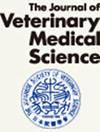以鸡直肠和盲肠肠内容物作为不同胃肠道的鸡艾美耳球虫卵囊检测及PCR鉴定评价
IF 1.1
4区 农林科学
Q3 VETERINARY SCIENCES
Journal of Veterinary Medical Science
Pub Date : 2025-09-05
Epub Date: 2025-07-24
DOI:10.1292/jvms.25-0252
引用次数: 0
摘要
本研究在家禽屠宰场采集蛋鸡肠道标本,用于评价艾美耳球虫感染情况。分别从直肠(从十二指肠到直肠)和盲肠提取肠内容物进行分析。采用浮选法检测,盲肠每克卵囊数高于直肠。聚合酶链反应分析还发现盲肠中的艾美耳球虫比直肠中的艾美耳球虫更丰富。这些结果表明,分析盲肠内容物可能对艾美耳球虫种类的检测和鉴定更有用。本文章由计算机程序翻译,如有差异,请以英文原文为准。
Evaluation of oocyst detection and PCR identification of chicken Eimeria species using intestinal contents of the rectum and cecum as different gastrointestinal tracts.
In the present study, intestinal specimens were collected from layer chickens at a poultry slaughterhouse and used to evaluate infection with Eimeria species. Intestinal contents were extracted separately from the rectum (from the duodenum to rectum) and cecum and used for analyses. Using flotation detection methods, the number of eimerian oocysts per gram was higher in the cecum than rectum. Polymerase chain reaction analysis also detected a greater abundance of Eimeria species in the cecum than the rectum. These results suggest that analysis of cecal contents could be more useful for detecting and identifying Eimeria species.
求助全文
通过发布文献求助,成功后即可免费获取论文全文。
去求助
来源期刊
CiteScore
2.30
自引率
8.30%
发文量
230
审稿时长
9-18 weeks
期刊介绍:
JVMS is a peer-reviewed journal and publishes a variety of papers on veterinary science from basic research to applied science and clinical research. JVMS is published monthly and consists of twelve issues per year. Papers are from the areas of anatomy, physiology, pharmacology, toxicology, pathology, immunology, microbiology, virology, parasitology, internal medicine, surgery, clinical pathology, theriogenology, avian disease, public health, ethology, and laboratory animal science. Although JVMS has played a role in publishing the scientific achievements of Japanese researchers and clinicians for many years, it now also accepts papers submitted from all over the world.

 求助内容:
求助内容: 应助结果提醒方式:
应助结果提醒方式:


